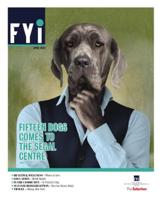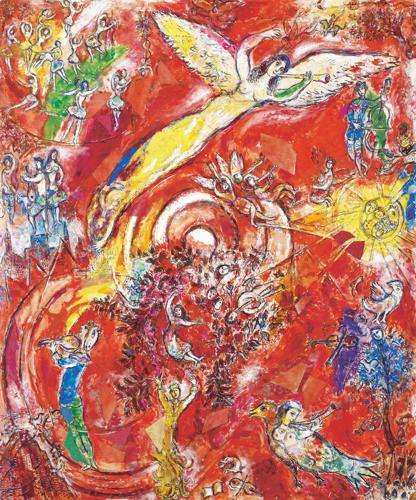In the art book that accompanies the exhibition Chagall: Colour and Music at the Montreal Museum of Fine Arts, the show’s musical director, pianist Mikhaïl Rudy, recounts a conversation between Marc Chagall and the composer Olivier Messiaen: “I see in your music the stained glass windows of Chartres Cathedral and the angels with trumpets, ” Chagall said. “It is in your stained glass that I hear Bach’s organ,” Messiaen responded.
The way music permeates Chagall’s oeuvre is the unifying theme of this exhibit, manifest in the artist painting the musical traditions of his childhood, designing costumes and backdrops for theatre, ballet and opera, and creating musical energy you can feel directly through his use of colours and brush strokes.
Chagall was born in 1887 and continued working until he was almost 98. He witnessed the Russian Revolution and two World Wars, and throughout he produced paintings, illustrations and drawings, stage sets, costumes, murals, sculptures and stained glass. He also wrote poetry and an autobiography.
The range of this exhibit, the largest and most comprehensive in Canada, is stunning, as it represents all aspects of Chagall’s creative universe, bringing together over 300 works in diverse media from major museums and private collections from around the world, including the State Tretyakov Gallery in Moscow, the Stedelijk Museum in Amsterdam, the National Museum of Modern Art – Centre Pompidou in Paris, and the Metropolitan Opera in New York, among others.
Musical excerpts significant to Chagall, such as klezmer and Mozart, are heard in many of the rooms, heightening the viewer’s the experience of being immersed in the artist’s mystical world rendered in luminous pure colour. Scale, impossible to experience through books, plays a role in the impact of the show as well, especially in the projection of the ceiling paintings Chagall completed for the Opéra de Paris in 1964 and the murals for the Metropolitan Opera at the Lincoln Center for the Performing Arts in New York in 1966.
Of the ceiling paintings, André Malraux, then minister of cultural affairs who commissioned the work has said, “What other living artist could have painted the ceiling of the Paris opera like Chagall did? He is one of the greatest colourists of our times.”
Chagall incorporated into his painting many of the avant-garde trends of the early 20th century, such as Cubism and Fauvism. Before the word “Surrealism” was coined, the poet and art critic Guillaume Apollinaire called his paintings “supernatural.”
But at the same time Chagall never abandoned the figure, which may be a reason why he is considered to be original and modern, yet accessible.
Many of his paintings, inspired by his childhood memories in his hometown Vitebsk in Belarus, depict the vanished world of Eastern European Jewish life. Shortly after immigrating to the U.S. in 1941, he heard about the German occupation of his beloved city. In an anguished letter, he wrote, “It has long been, my favourite city, that I have not seen you, did not rest on your fences. I did not live with you, but there was not a single one of my paintings that did not reflect your joy and sorrow.”
These joys and sorrows live on in Chagall’s work, inviting the viewer to enter his vision and uncover the layers of meaning within. Chagall has said that colour is vibration, “like music,” and that “all our interior world is reality, perhaps more so than our apparent world”. While the figures seem to be in perpetual motion as they float across the canvas evoking a surreal dreamlike atmosphere, the expressions on many of the faces, (even in eyes of the animal symbols he depicts, like the rooster, or in his Fable de La Fontaine illustration of the fox longing for a bunch of grapes) are compellingly real.
Though life in an Eastern European village seems remote, the people in the paintings are simply living their lives. Like us, they are born, they marry, they celebrate and they grieve through the recurring dance of life.
Associated programming in the form of lectures and films enriches the experience of discovering the art of Marc Chagall. Upcoming events, at the Maxwell Cummings Auditorium, include Harry Rask’s documentary Homage to Chagall: The Colours of Love on February 26. On March 2, Sonia Del Re, associate curator of the National Gallery of Canada will present Labor of Love: Marc Chagall’s Daphnis & Chloé.
Chagall: Colour and Music is on until June 11, 2017 at the Montreal Museum of Fine Arts, 1380 Sherbrooke W. The Maxwell Cummings Auditorium is located at 1379-A Sherbrooke W. Info: 514 285-2000 www.mbam.qc.ca









(0) comments
Welcome to the discussion.
Log In
Keep it Clean. Please avoid obscene, vulgar, lewd, racist or sexually-oriented language.
PLEASE TURN OFF YOUR CAPS LOCK.
Don't Threaten. Threats of harming another person will not be tolerated.
Be Truthful. Don't knowingly lie about anyone or anything.
Be Nice. No racism, sexism or any sort of -ism that is degrading to another person.
Be Proactive. Use the 'Report' link on each comment to let us know of abusive posts.
Share with Us. We'd love to hear eyewitness accounts, the history behind an article.